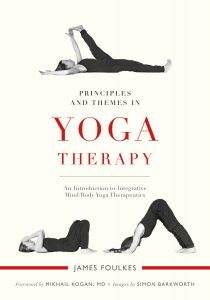The team at Singing Dragon would like to thank everyone who signed up, read, watched, listened or interacted with our first ever Virtual Yoga Summit. We believe that yoga really is for every body and we hope we managed to embrace that in this summit, putting a strong focus on accessibility, body positivity, empowerment and on yoga’s ‘whole person’ approach. Continue reading
yoga
Marlysa Sullivan: A meditation practice of inner well-being

Marlysa Sullivan is an assistant professor of Yoga Therapy and Integrative Health Sciences at Maryland University of Integrative Health. She is also adjunct faculty at Emory University in the doctor of physical therapy where she teaches an elective on integrating yoga into physical therapy care. Her research interests have focused on developing an explanatory model of yoga therapy based on philosophical and neurophysiological principles. She is the co-editor of the book Yoga and Science in Pain Care: Treating the Person in Pain (Singing Dragon, 2019).
In this video, Marlysa guides viewers through a meditation practice for inner well-being.
 Yoga and Science in Pain Care
Yoga and Science in Pain Care
Treating the Person in Pain
Edited by Neil Pearson, Shelly Prosko and Marlysa Sullivan. Foreword by Timothy McCall.
This is an integrated approach to pain rehabilitation that combines pain science, rehabilitation and yoga with evidence-based approaches from respected contributors. The book shows how to integrate the practices of yoga and pain science, and promotes the movement to a patient-valued, partnership-based biopsychosocial-spiritual model of healthcare. Read more
Neil Pearson: Informing the Language of Yoga Teachers with Pain Science
Language is  powerful, as is pain. Both can be forceful motivators of behavioural change. Spoken language can be interpreted in many ways. Sometimes we even question whether words mean what we think they mean. Pain can be the same. We wonder whether pain really is intended to “get us to stop or change our behaviour”. We might also wonder “exactly what is it that I am supposed to change? Maybe the change I need to make is to stop responding this way to my pain!”
powerful, as is pain. Both can be forceful motivators of behavioural change. Spoken language can be interpreted in many ways. Sometimes we even question whether words mean what we think they mean. Pain can be the same. We wonder whether pain really is intended to “get us to stop or change our behaviour”. We might also wonder “exactly what is it that I am supposed to change? Maybe the change I need to make is to stop responding this way to my pain!”
As a yoga teacher, leading groups in asana requires instructions that will keep your students safe. As such, cognitive contemplations such as the above are not well-suited as part of an asana practice dialogue. We use language that guides our students to be aware of what is happening in the present moment. We guide them to find the right challenge so they can explore preconceived notions, all the while staying present with, and not ignoring what’s happening now. We use language that provides options for change. “What would happen if you changed the way you are breathing right now?” “Or what you are thinking?” “Or if you let go of some of the aversion to the emotions or tension that you are feeling in your body right now?” In other words, we use language that encourages awareness and language that encourages self-regulation – often of body, breath, thoughts and emotions. Note that this language of awareness is not the same as asking a student to be aware “as the first step to change”. This is language that focuses on awareness as important in and of itself. Continue reading
Aggie Stewart: The Essence of Self
We are very sorry that our last live contributor, Aggie Stewart, won’t be able to share her live session with you today. We wish her the very best and hope she feels better soon! To ensure that she is still part of the Summit, we share a short extract from Aggie’s new book, ‘Yoga as Self-Care for Healthcare Practitioners‘. We do hope you enjoy it.

Self-care is never a selfish act—it is simply good stewardship of the only gift I have, the gift I was put on earth to offer others. Anytime we can listen to true self and give the care it requires, we do it not only for ourselves, but for the many others whose lives we touch.
Parker J. Palmer
This is a challenging time to be a healthcare professional. Whether in education and clinical training or in professional practice, major aspects of the healthcare education and delivery landscape present inherent and well‑documented risks to the health and well-being of students and practitioners.
Currently, the effects of the epidemic of burnout and self-harm, blunted empathy, compassion fatigue, absenteeism, and attrition are being felt across the health professions. Research into the factors underlying the current state of practitioner wellness indicates that, for many, signs of burnout and its related consequences emerge during the education and training period and go unattended as graduates step into professional life.
As the healthcare professions grapple with the range of environmental and cultural issues that contribute to the current state of practitioner wellness, self-care has emerged as a pressing need for both students and practitioners. Broadly defined, self-care encompasses the ability to recognize and respond in an appropriate and positive manner to one’s needs on all levels: physical, energetic, mental, emotional, and spiritual. Increasingly, health professional schools, healthcare settings, and health professional associations are providing education on the importance of self‑care on all these levels along with training on specific aspects of selfcare, such as diet, exercise, finances, and activities that support self-care, such as yoga and other mind–body–spirit practices. Continue reading
Lana Skrypnyk: Creating a Safe Space for the LGBTQ+Community

As I write this, hate crimes against the LGBTQ+ community are at their highest. A poll indicates that two-thirds of people identifying as LGBTQ+ are afraid for their safety when holding hands or displaying affection for their partners in public. 59% of all of those identifying as LGBTQ+ and 81% of those who are transgender report being called a slur in reference to their sexual and/or gender identity in the past year.
As I write this, I myself stand at a cross-roads of intersectionality. As a naturalized citizen immigrant, queer-identifying individual with several invisible disabilities, I have been afraid and anxious since 2016. I am also someone who suffers from mental health issues, including complex PTSD, and someone occupying a larger body than society deems “acceptable”. I have not always had the means to access healing spaces – such as the one that yoga can provide – for a variety of reasons, with cost and lack of representation by people looking like me at the top of the list. Unfortunately, with the Westernization of yoga and its cooptation by the fitness industry, high-end studio fees, expensive athletic clothing and equipment, and traditionally attractive, young, flexible white women on Instagram have become the norm associated with yoga. By sheer luck, I was able to get a Groupon deal to a local yoga studio that provided both diversity and a space where I felt safe enough to explore. I fell in love with yoga and decided I wanted to become a teacher in that very first class. For the first time in weeks, if not in my entire life, I was able to get out of my head for an hour, drop the persona so many of us who identify as LGBTQ+ or are “other” in some way have to keep up during the day, and just be. I wanted to provide the same experience to others like me. Continue reading
Susan E. Longtin and Jessica A. Fitzpatrick: Partner Yoga for Autism

Autism spectrum disorder (ASD) refers to a broad category of neurodevelopmental disabilities defined by two core characteristics, namely 1) impairments in social communication and social interaction and 2) the presence of restricted, repetitive patterns of behaviors, interests, and activities (American Psychiatric Association 2013). Deficits in both of these areas must be present in order for an individual to be diagnosed with ASD. ASD affects the abilities to initiate and maintain interactions, establish appropriate eye contact, and take turns with others. Although the onset of the condition must occur in the early developmental period, usually before three years, symptoms might not manifest until somewhat later when the demands of social communication exceed the child’s capacities and often persist across the lifespan. ASD has increased in prevalence over the past two decades, perhaps due to a widening of the spectrum to include milder cases, increased awareness of the early signs of the disability, a combination of the two, or some other factor. About 1 in 59 children has been identified with ASD according to the most recent estimate from the Centers for Disease Control and Prevention.
The introduction of yoga to children with ASD can build strength, balance, and flexibility. The practice of yoga for these children also presents numerous other physical, cognitive, and emotional benefits. Yoga provides a relaxed, playful environment that stimulates communication and socialization. Since children with ASD exhibit difficulty with social-relatedness, partner yoga, in particular, can promote eye contact, joint attention, and reciprocity among peers. In addition, children with ASD tend to engage in more solitary, concrete play of a repetitive nature rather than cooperative, symbolic play. Continue reading
Nicola Harvey: A Mindful Approach to Emotional Regulation

Nicola Harvey is an experienced and qualified Wellbeing & Mindfulness practitioner, Special Needs teacher and therapist. Her internationally acclaimed book, Mindful Little Yogis, was published by Singing Dragon in 2018.
In her video, Nicola discusses emotional regulation, mindfulness, and shares some practical tips and exercises for both children and adults.
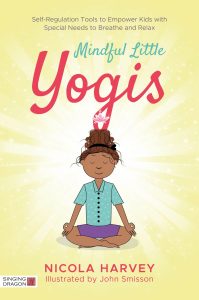 Mindful Little Yogis
Mindful Little Yogis
Self-Regulation Tools to Empower Kids with Special Needs to Breathe and Relax
Nicola Harvey, illustrated by John Smisson
This practical and creative book is filled with simple calming activities to help children find a sense of peace and settle heightened emotions during busy times. Each activity is easily adaptable for different ability levels, providing a handy bank of self-regulation tools that can be used at any time in a range of settings. Read more
Shawnee Thornton Hardy: Making Yoga Accessible – Head to our Facebook Page Now!
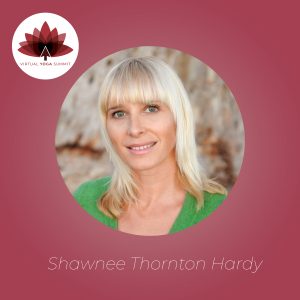
Shawnee is a C-IAYT-certified yoga therapist, M.Ed., 500 E-RYT and RCYT (Registered Children’s Yoga Teacher). She is the founder of Asanas for Autism and Special Needs and the founder/director of Yoga Therapy for Youth Teacher Training Program. Shawnee has worked with children and adults with autism and special needs for over 20 years, specializing in working with children and adults with significant cognitive and language delays, sensory processing deficits, as well as severe behavior challenges. She wrote and published a book, Asanas for Autism and Special Needs – Yoga to Help Children with Their Emotions, Self-Regulation and Body Awareness (Singing Dragon, 2014), is the creator of the C.A.L.M.M Yoga Toolkit and is currently working on her new book Yoga Therapy for Children and Teens with Complex Needs, to be published by Singing Dragon in 2021. She has a yoga school through Yoga Alliance in order to train others in yoga approaches to support children and adults with complex needs and travels globally to share her teachings.
CLICK HERE TO JOIN SHAWNEE’S LIVE WEBINAR NOW
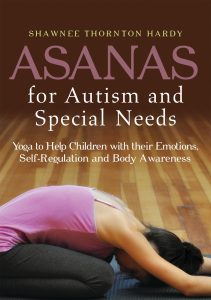 Asanas for Autism and Special Needs
Asanas for Autism and Special Needs
Yoga to Help Children with their Emotions, Self-Regulation and Body Awareness
Shawnee Thornton Hardy
Teaching yoga to children with Autism Spectrum Disorder and other special needs is easy using this visual how-to handbook. Breaking down yoga instruction pose by pose, body part by body part, breath by breath, this book uses easy-to-understand language and clear photographs to show parents, teachers, yoga instructors, and other professionals how to introduce the life-long benefits of yoga to a child with special needs. Read more
Donna Noble: Body Positivity – Head to our Instagram Now!
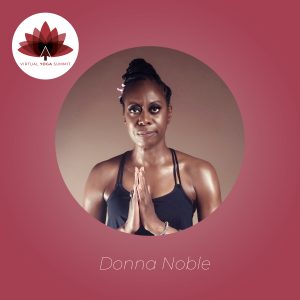
Donna Noble has been practising yoga since 1999. She is the creator of CurveSomeYoga. She has been a certified yoga specialist since 2011 with the Yoga Alliance and British Wheel of Yoga. She is also a certified NLP Master Practitioner. As well as teaching in New York and Texas she teaches all over the UK, and also taught at the Om Show, runs workshops and yoga retreats. She hosts her own show “The Noble Art of Wellbeing” on Natural Health Radio as well as being a fitness writer and blogger. She is on a mission to make yoga more accessible and diverse.
Donna is currently working on a book for Singing Dragon about making yoga classes body positive, due to be published in 2021.
James Foulkes: Yoga Therapy and Lifestyle Medicine

James Foulkes is a yoga teacher and IAYT Registered Yoga Therapist. Originally from England, James has trained for 15 years with the students of Vanda Scaravelli.
His book, Principles and Themes in Yoga Therapy was released by Singing Dragon in 2017.
At present, James operates a busy Yoga Therapy Practice, and has taught on numerous Yoga Therapy trainings and Yoga Teacher trainings. He conducts classes and workshops around the Washington DC Area, around the United States and internationally.
In this video James discusses yoga therapy and lifestyle medicine, touch, complex illness as well as using yoga therapy to support those who have been incarcerated.
Principles and Themes in Yoga Therapy
An Introduction to Integrative Mind/Body Yoga Therapeutics
James Foulkes, Foreword by Mikhail Kogan, MD, illustrated by Simon Barkworth
Provides a brief history of yoga therapy before offering a new way to think about anatomy and the wholeness of the human being. Through case studies, the author explores different principles of practice with tips for yoga therapy practitioners to develop their working client relationship and their own conditioning. Read more
